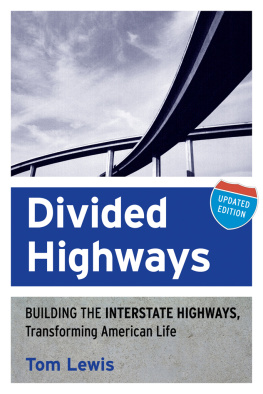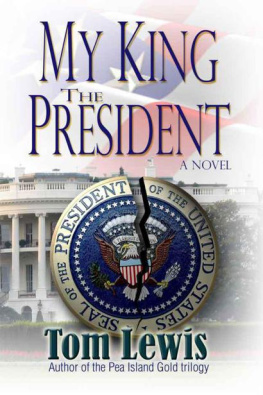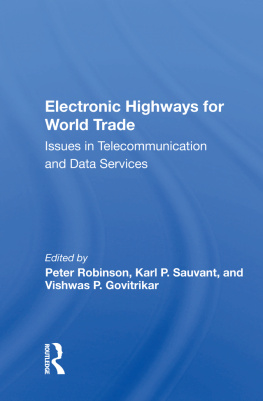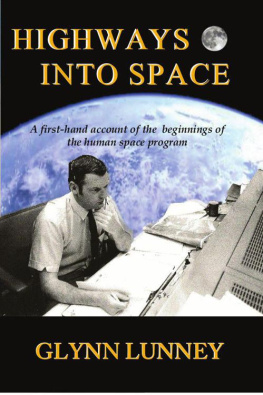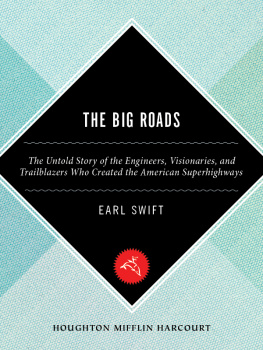Preface to the Cornell Edition
The December 1956 Harpers Magazine published an article about the new Interstate Highway bill that President Dwight Eisenhower had recently signed into law. This new highway program, the writer concluded, will affect our entire economic and social structure. The appearance of the new arteries and their adjacent areas will leave a permanent imprint on our communities and people. They will constitute the framework within which we must live. That these heady words came from the pen of Americas foremostand most arrogantplanner and highway builder of the time, Robert Moses, is of no matter. Beyond Mosess imperious tone, we can see that the events in the next half-century bore out his prophecy. This book explores the ways the Interstate Highway System helped to change the nations economy and transform its society.
As I reflect upon this history, the Interstate Highway System seems more than ever to stand as a paean to Americas navet. Americans conceived of the system in an age of guiltlessness, as writer John Updike observed. Our fat fifties cars, how we loved them, revved them; no thought of pollution. Exhaust smoke, cigarette smoke, factory smoke, all romance. Romance of consumption at its height. Yet it was also a time when Americans and their leaders could conceive and embrace a large-scale project such as the Apollo moon mission or the Interstates. The Federal Highway Act of 1956, the legislation that created the Interstate Highway System, takes its place beside the Civil Rights Act of 1964, as two of the most important domestic federal measures of the second half of the twentieth century.
That the most successful public works program in the history of the world, as the columnist George Will has characterized the Interstate Highway System, should come from the Eisenhower administration has always seemed an irony to some. But the conservative Republican understood that a sensible government road-building program could expand the economy in the present and the future. Growing up as he had in a railroad town, Abilene, Kansas, Eisenhower understood better than others that improving automobile transportation in the twentieth century would have the same effect on the entire nation as the railroad expansion into the west had in the nineteenth. Though he did not drive a car, his experience with buggies, horses, hitching posts, and mud in Abilene taught him about isolation and the unwanted limitations it imposed. He knew that the Interstates would foster communication and help to bind the nation.
Eisenhower was president in a period of relative agreement that the federal government should play an important role in Americas transportation. Though the Republicans controlled neither the House nor the Senate in 1956, and he was running for a second term, Eisenhower worked with leaders of both parties to secure the acts passage and a responsible way to pay for it through an increase in the federal gasoline tax. Since that time, the apex of what many have called the American Century, important transformations have taken place in American attitudes. Today, many Americans believe that the federal government is too intrusive in state affairs and are reluctant to pay for any domestic federal program that involves a tax increase.
Surely the greatest change in American attitudes may be seen in the relative timidity of its leaders to embrace bold and visionary programs like the Interstate Highway System or the Apollo moon missions. Vision of that sort comes with a tax bill and relies on a confidence in the future. In this age of contraction, when the government is content to privatize its space program and highways, such farsightedness is at a premium.
Yet as this new edition of Divided Highways shows, even in the 1950s planners should have tempered their bold vision with the reality that the country could not sustain even conservative estimates of the number of automobiles that would flood the new highways. The negative effects of the Interstate Highway System on America lifepollution, sundering of cities, destruction of wetlands, suburban sprawl, and the inefficient use of fuel, to name just a fewcannot be ignored. In many ways this book charts Americas metamorphosis from navet and guiltlessness to contrition and prudence.
For this new edition I have added a chapter to bring the history of the conception and construction of the Interstate Highway System to its formal conclusion. It contains the story of the buried, realigned, and new highways completed in the city of Boston in 2006, and an account of the shift in federal policy to integrate the highways with other forms of transportation.
I have taken this opportunity of a new edition to correct several errors that marred the first, and I thank those astute readers and reviewers who pointed them out to me. I must reserve my greatest thanks to Michael McGandy, acquisitions editor at Cornell University Press. For his interest, support, and, above all, careful editing, I am in his debt.
TOM LEWIS
Saratoga Springs, New York
Preface: A Space Filled with Moving
Think of anything, of cowboys, of movies, of detective stories, of anybody who goes anywhere or stays at home and is an American and you will realize that it is something strictly American to conceive a space that is filled with moving, a space of time that is filled always filled with moving.
GERTRUDE STEIN
This is the story of the creation and consequences of the greatest and the longest engineered structure ever built, the Interstate Highway System. Imagine the state of Connecticut knee deep in earth; thats how much was moved for the Interstates. Or a wide sidewalk extending from the earth to a point in space five times beyond the distance to the moon; thats how much concrete was poured for the Interstates. Or a land mass the size of the state of Delaware; thats how much property highway authorities acquired in order to site the Interstates. Or enough drainage culverts to handle all the needs of a city six times the size of Chicago; thats how much was laid beneath the Interstates. The Great Wall of China and the Interstate Highway System are among the few human creations that can be seen by astronauts from an orbiting spacecraft.
But statistics are the least interesting chapter in the story. The highways became a stage on which we have played out a great drama of contradictions that accounts for so much of the history of this century. On this stage we see all our fantasies and fears, our social ideals and racial divisions, our middle-class aspirations and underclass realities.
The system connects American cities and people in a vast web of roads that carry the life of the nation; yet to build it, tens of thousands of Americans were dispossessed of their land and saw their homes and neighborhoods destroyed. It gave Americans almost complete mobility and yet endless congestion. It ranks as the greatest public works project in the history of the nation, though its plan was set in motion by a Republican president who disliked the excessive authority of big government. It was first conceived of by highway planners in the thirties when Americans considered the automobile one of the blessings of the modern age; in the eighties, when it was nearly complete, many considered the automobile a blight. It made many people wealthy, dispossessed others and left them in poverty. In 1956, when the U.S. Congress enacted the legislation to create it, politicians and writers celebrated the goal of mans triumph over nature; by 1991, when the last section of Interstate 90 was opened, connecting Boston to Seattle with a three-thousand-mile strip of concrete, some regarded that triumph as a tragedy. It enabled us to speed across the land into vast stretches of wilderness; yet it distanced us from the very land we sought. It added new words to our vocabulary, like beltway and drive time, and it lent new meaning to old ones like smog and pollution, ecology and environment, traffic jam and pileup.


